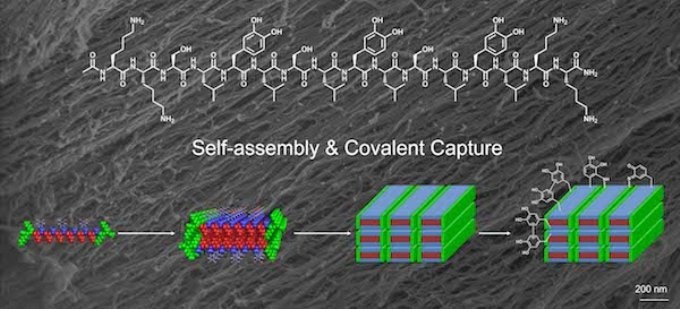Jun 12 2017
Chemists at Rice University have taken inspiration from the mussel to put the muscle into their new macroscale scaffold fibers.
 Rice Chemists used the adhesive ability of a compound found in mussels and shear force to help a nanoscale, multidomain peptide, seen at top, self-assemble into a fiber bundle that can be picked up with a tweezer. The researchers said the fiber may aid in the manipulation of cell cultures, among other applications. Courtesy of the Hartgerink Research Group
Rice Chemists used the adhesive ability of a compound found in mussels and shear force to help a nanoscale, multidomain peptide, seen at top, self-assemble into a fiber bundle that can be picked up with a tweezer. The researchers said the fiber may aid in the manipulation of cell cultures, among other applications. Courtesy of the Hartgerink Research Group
The Rice lab of Chemist Jeffrey Hartgerink has discovered how to create biocompatible nanofibers from synthetic peptides. In a new study, the lab is employing an amino acid found in the sticky feet of mussels to make those fibers line up into robust hydrogel strings.
Hartgerink and Rice Graduate Student I-Che Li announced their room-temperature technique this month in an open-access paper in the Journal of the American Chemical Society.
Using tweezers the hydrogel strings can be picked up and moved. Li said he hopes they will help labs have optimal control over the growth of cell cultures.
Usually when cells grow on a surface, they spread randomly. There are a lot of biomaterials we want to grow in a specific direction. With the hydrogel scaffold aligned, we can expect cells to grow the way we want them to. One example would be neuron cells, which we want to grow head-to-tail to aid nerve regeneration. Basically, this could allow us to direct cell growth from here to there. That’s why this material is so exciting.
I-Che Li, Rice Graduate Student
In earlier research, Hartgerink’s lab had created synthetic hydrogels that could be injected into the body to act as scaffolds for tissue growth. The hydrogels consisted of hydrophobic peptides that self-assembled into fibers about 6 nm wide and up to several microns long. However, since the fibers did not interact with one other, they mostly appeared in microscope images as a twisted mass.
Experiments revealed the fibers could be coaxed into alignment with the application of shear forces, similar to the way playing cards are aligned while shuffling by pushing on both the top and bottom of the deck.
Hartgerink and Li planned to try pushing the fibers via a needle to force them into alignment, a process that would be simpler if the material was water soluble. Therefore they added a string of amino acids known as DOPA to the sides of the fibers to allow them to stay water-soluble in the syringe, Li said.
DOPA — short for 3,4-dihydroxyphenylalanine — is the compound that allows mussels to stick to virtually anything. Hartgerink and Li discovered that the combination of DOPA and shear stress from passing via the needle stimulated the fibers to form visible, rope-like bundles.
They also found that DOPA boosted chemical cross-linking reactions that helped the bundles keep their shape.
DOPA is really sensitive to oxidizing agents. Even exposing DOPA to air oxidizes it, and that aids in cross-linking the fibers.
I-Che Li, Rice Graduate Student
As an extra advantage, the aligned fibers also proved to have a curious and valuable optical property called “uniform birefringence,” or double-refraction. Li said this could allow Researchers to use polarized light to observe precisely where the aligned fibers are, even if they are covered by cells.
“This will be an important technique for us to make sure of the long-range order of fiber alignment when we are testing directed cell growth,” he said.
The researchers believe the aligned fibers can be employed in macroscale medical applications but with nanoscale control over the structures.
Self-assembly is basically the ability of a molecule to make ordered structure from chaos, and what I-Che has done is push this organization to a new level with his aligned strings. With this material, we are excited to see if we can impose this organization onto the growth of cells that interact with it.
Jeffrey Hartgerink, a Professor of Chemistry and Bioengineering
The research was supported by Robert A. Welch Foundation and the National Institutes of Health.